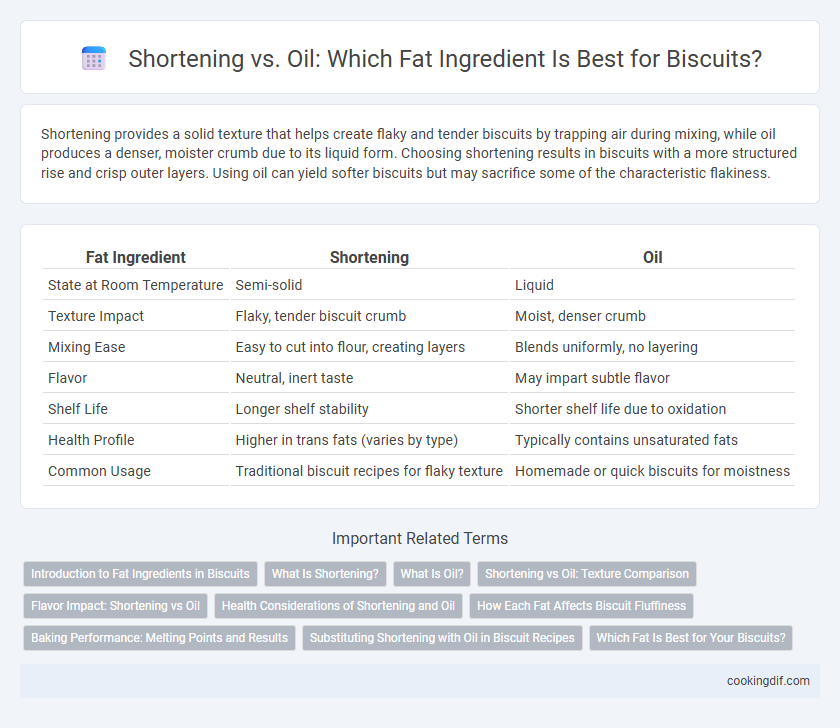Shortening provides a solid texture that helps create flaky and tender biscuits by trapping air during mixing, while oil produces a denser, moister crumb due to its liquid form. Choosing shortening results in biscuits with a more structured rise and crisp outer layers. Using oil can yield softer biscuits but may sacrifice some of the characteristic flakiness.
Table of Comparison
| Fat Ingredient | Shortening | Oil |
|---|---|---|
| State at Room Temperature | Semi-solid | Liquid |
| Texture Impact | Flaky, tender biscuit crumb | Moist, denser crumb |
| Mixing Ease | Easy to cut into flour, creating layers | Blends uniformly, no layering |
| Flavor | Neutral, inert taste | May impart subtle flavor |
| Shelf Life | Longer shelf stability | Shorter shelf life due to oxidation |
| Health Profile | Higher in trans fats (varies by type) | Typically contains unsaturated fats |
| Common Usage | Traditional biscuit recipes for flaky texture | Homemade or quick biscuits for moistness |
Introduction to Fat Ingredients in Biscuits
Fat ingredients like shortening and oil play a crucial role in biscuit texture and flavor development. Shortening, a solid fat at room temperature, creates tender, flaky layers by trapping air and providing structure during baking. Oils, being liquid fats, contribute to moistness and softness but may result in less flaky biscuits compared to shortening.
What Is Shortening?
Shortening is a solid fat made from vegetable oils that are hydrogenated to achieve a stable, crumbly texture ideal for biscuit dough. Unlike liquid oils, shortening helps create tender layers by trapping air during mixing, resulting in flakier, softer biscuits. Its ability to maintain shape during baking makes shortening a preferred fat for achieving consistent biscuit quality.
What Is Oil?
Oil is a liquid fat derived from plants, seeds, or fruits, commonly used in biscuit recipes to provide moisture and tenderness. Unlike shortening, which is solid at room temperature, oil remains liquid, promoting a softer, more delicate crumb in baked goods. Its unsaturated fatty acid content helps create a lighter texture and can enhance the flavor profile of biscuits.
Shortening vs Oil: Texture Comparison
Shortening creates a flaky and tender texture in biscuits due to its solid state at room temperature, which helps trap air and form distinct layers during baking. Oil, being liquid, produces a softer and more uniform crumb but lacks the flaky characteristic of shortening-based biscuits. Choosing shortening over oil results in a more traditional, flaky biscuit texture preferred in many classic recipes.
Flavor Impact: Shortening vs Oil
Shortening imparts a rich, buttery flavor to biscuits due to its hydrogenated fats, creating a tender, flaky texture that enhances mouthfeel. Oil, particularly vegetable or olive oil, produces a softer crumb with a lighter taste, allowing other flavors like herbs or cheese to be more pronounced. The choice between shortening and oil significantly influences the biscuit's flavor profile and texture, depending on the desired sensory experience.
Health Considerations of Shortening and Oil
Shortening often contains trans fats, which are linked to increased risk of heart disease and inflammation, while many oils, such as olive or canola oil, offer healthier unsaturated fats that support cardiovascular health. Choosing oils with high smoke points, like avocado or sunflower oil, can maintain nutritional quality during baking without producing harmful compounds. Understanding the fat type and its impact on cholesterol and inflammation is essential when selecting between shortening and oil for healthier biscuit recipes.
How Each Fat Affects Biscuit Fluffiness
Shortening creates a tender, flaky texture in biscuits by coating flour proteins and limiting gluten formation, which results in higher fluffiness. Oil, lacking the solid structure of shortening, produces denser biscuits with less lift and crumb softness. For maximum fluffiness, solid fats like shortening are preferred due to their ability to trap air during mixing and baking.
Baking Performance: Melting Points and Results
Shortening in biscuits provides a higher melting point, which creates a flakier texture by maintaining solid fat layers during mixing and initial baking stages. Oil, with its lower melting point, results in a softer crumb and denser texture due to its liquid state at room temperature, promoting even moisture distribution. The choice between shortening and oil directly influences biscuit structure, spread, and mouthfeel, making shortening ideal for tender, layered finishes while oil favors moistness and pliability.
Substituting Shortening with Oil in Biscuit Recipes
Substituting shortening with oil in biscuit recipes affects texture, moisture, and flavor, with oil typically producing softer, more tender biscuits due to its liquid state. Oils like vegetable or canola oil enhance moisture retention but may reduce flakiness compared to solid shortening, which creates distinct layers in the dough. Adjusting oil quantity and incorporating chilling steps can help replicate the desirable crumb structure found in shortening-based biscuits.
Which Fat Is Best for Your Biscuits?
Shortening is ideal for biscuits due to its solid consistency at room temperature, which creates flakier layers and a tender crumb by trapping air during mixing. Oil, being liquid, yields softer, denser biscuits with a moister texture but less lift and flakiness. For optimal biscuit texture and rise, solid fats like shortening or cold butter are generally preferred over liquid oils.
Shortening vs Oil for fat ingredient Infographic

 cookingdif.com
cookingdif.com